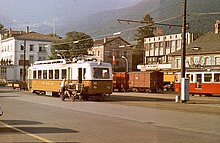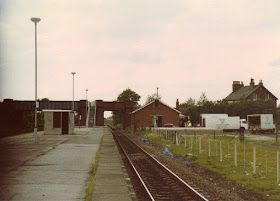FACEBOOK - RAIL THING SUISSE - AIGLE-LEYSIN
RAILFILE - AIGLE-LEYSIN
Aigle–Leysin railway
From Wikipedia, the free encyclopedia
| Aigle–Leysin railway | |
|---|---|
 | |
 | |
| Overview | |
| Termini | Aigle Leysin, Switzerland |
| Operation | |
| Opened | 1900-1915 |
| Owner | Transports Publics du Chablais |
| Operator(s) | Transports Publics du Chablais |
| Depot(s) | Aigle |
| Technical | |
| Line length | 6.209 km |
| Track gauge | 1,000 mm (3 ft 33⁄8 in) |
| Electrification | 1500 V DC |
| Highest elevation | 1,047 m (3,435 ft) |
| Maximum incline | 23 % |
| Rack system | Abt |
The Aigle–Leysin railway (French: Chemin de fer Aigle–Leysin, AL) was the earliest of the narrow gauge line in the Chablais area of south west Switzerland. The line was opened on 5 May 1900, a1,000 mm (3 ft 33⁄8 in)-gauge cog-wheel railway using the Abt rack system.
Nowadays it is joined in Aigle's main railway station by express trains of the Swiss Federal Railways together with those of three other, local, narrow-gauge railways: the Aigle-Ollon-Monthey-ChampéryRailway (AOMC), the Aigle–Leysin Railway and the Aigle-Sépey-Diablerets Railway (ASD).
[1]History
- 5 May 1900 : opening of the section from Aigle CFF station - Grand-Hôtel des Bains (Aigle).[2]
- 5 November 1900 : opening of the section from Grand-Hôtel des Bains - Feydey (Leysin)
- 1912 : The line between Leysin-Village et Leysin-Feydey is doubled
- September 1915 : Extension of the line to the current terminus at Leysin-Grand Hôtel.
- In 1946, the rolling stock was renewed, and the traction current voltage was changed from 650 to 1300 volts. This allowed the journey time to be reduced to around 30 minutes.
The route
The Aigle–Leysin railway line is 6.5 km (4.04 mi) long and rises 1,047 m (3,435 ft) from its terminus outside the main line station in Aigle to its summit at the Grand Hôtel at Leysin. The first 1 km of the route is through the streets of Aigle from the railway station to the railway depot where the train reverses to enable the powered vehicle to be at the rear of the train for the uphill journey, normal working on a rack (cog-wheel) railway. From this point the line climbs steeply through the vineyards, the steepest gradient being 1 in 4.3 (23%).
The operating voltage of the line has changed four times, increasing from 600 V DC at opening, first to 650 V DC, then in 1946 to 1300 V DC, and later to the present operating voltage of 1500 V DC.
Mergers
In 1975 the four local railway companies, Aigle–Leysin, Aigle–Ollon–Monthey–Champéry, Aigle–Sépey–Diablerets and Bex–Villars–Bretaye (BVB) merged to form a single operating company, known as the Transports Publics du Chablais (TPC). This brought about increased co-operation between the companies in the provision of community-based services.
Federal involvement
In 1985, the Federal Government informed the Aigle–Leysin Railway, and other privately operated railways, that it would cease all funding the following year, however they renewed a federal concession for a further period of 50 years. An agreement was signed between the Canton of Vaud, the communities served by the railway and the Aigle–Leysin Railway and its partners to renew rolling stock and upgrade the track.
In the mid-1990s, faced with greatly increased operating costs, the Canton of Vaud and the communities served by the railway petitioned the Federal Government to revoke its 1985 decision. The Federal Government did so and in 1996, recognizing the importance of this regional line as a public transportation carrier, awarded the line with a contract to provide a public transportation service. This brought about, in 1999, talks which resulted in the founding, the following year, of Transports Publics du Chablais as the parent body of local public transportation with the four local railway companies as founding members. The railway now operates as line A under the TPC banner.
Locomotives, railcars and rolling stock
The line owns just two locomotives. Their class He 2/2, built by SLM /SIG in 1915 was rebuilt in the company workshop during 2006/7, and has returned to service in near original condition and in its original red livery. They also have a 1949-built class Te 2/2.
The "automotrices" (railcars), painted in a light chocolate and cream livery, are, with the exception of No. 201 which is a class Arseh 2/4, of class BDeh 2/4. The company also owns 5 "Voiture Pilote"(driving trailers) of class Bt and retains 2 older coaches, class B2 for historic trains.
Details from official stock lists, May 2006 and personal observations 2006-2009.
| No. | Name | Class | Builders Details. | Date Completed | Notes |
|---|---|---|---|---|---|
| 12 | He 2/2 | 1915 | Static monument, En Chalex | ||
| 101 | Te 2/2 | Reb. AL | 1949 | Rebuilt 2006/7, returned to traffic, 2008. Out of service, Les Diabrelets, Sept 2009. | |
| 201 | Arseh 2/4 | SLM/BBC | 1946 | Converted to 1st class Restaurant Car | |
| 202 | BDeh 2/4 | SLM/BBC | 1946 | ||
| 203 | BDeh 2/4 | SLM/BBC | 1946 | ||
| 301 | Aigle | BDeh 2/4 | SIG/SAAS | 1966 | |
| 302 | Leysin | BDeh 2/4 | SIG/SAAS | 1966 | |
| 311 | Yvorne | BDeh 2/4 | Vevey/BBC | 1987 | Ex-No. 303 |
| 312 | Ollon | BDeh 2/4 | Vevey/BBC | 1987 | Ex-No. 304 |
| 313 | La Berneuse | BDeh 2/4 | Vevey/BBC | 1993 | Ex-No. 305 |
| 351 | Bt | SIG/SAAS | 1966 | ||
| 352 | Bt | SIG/SAAS | 1966 | ||
| 361 | Bt | ACMV/SIG/BBC | 1987 | Ex-No. 353 | |
| 362 | Bt | ACMV/SIG/BBC | 1987 | Ex-No. 354 | |
| 363 | Bt | ACMV/SIG/BBC | 1993 | Ex-No. 355 | |
| B2 | 1900 | ||||
| B2 | 1955 |
Abbreviations
- BBC : Brown, Boveri & Cie
- ACMV : Ateliers Construction Mechaniques de Vevey
- SIG : Schweizerische Industrie Gesellschaft
- SLM : Swiss Locomotive and Machine Works
- Vevey : Vevey Technologies (previously ACMV).





































